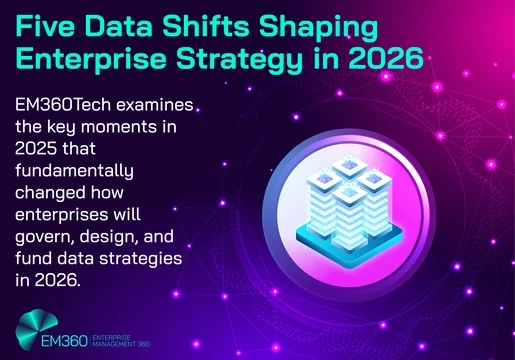Data is an increasingly valuable commodity in the enterprise. Simultaneously, our rate of data generation has increased by leaps and bounds over the past few decades. This is excellent news for enterprises, as a mass influx of high-quality data are the perfect harvesting grounds for extracting meaningful insight.
Another paradigm shift in the business world has been the move to customer or user experience—beyond the products or services themselves. There has never been more competition than we see presently, and this has forced enterprises to try and find new ways to differentiate themselves from the competition. Anybody can come along and deliver products from a warehouse, but the quality of the delivery and aftercare experience is fast becoming more important than the product itself.
Indeed, most marketers today work under the assumption that customer experience will be the primary source of enterprise competition within the next few years. It has been proven that a positive overall customer experience elicits a positive emotional response in consumers: increasing loyalty and attracting new customers in search of a similar experience. With the customer experience being so important, what steps can you take to leverage this evolution in the consumer mindset?

Visibility is Key
Enterprises often harbor more insightful data than they realize. And the barrier to accessing this insight is visibility. Until recently, data analytics was tricky business due to segmented IT silos and overly complicated methods of interdepartmental communication. This is where modern database platforms and data analytics tools have brought tremendous value.
Breaking down these silos and streamlining communication across the business is the first step to extracting more insight. This can be accomplished by centralizing your data storage into a single database, acting as a unified gateway for data access and insight generation for your business. A common term in data science is the single source of the truth (SSOT), where you have one storage location that acts as a singular reference point for all employees and workflows. This directly helps streamline business communication, as you no longer need to contest with varying departmental toolsets and data storage locations. Everyone has access to the same information, and thus a consensus naturally arises.
Once you have established a SSOT, your enterprise is ready to start understanding the hidden insights in your data and how it can benefit the customer experience.
Customer Analytics for a Better Customer Experience
At all stages of the sales funnel, you should be trying to collect data: starting from a website visit, right up until delivery at the customer's door. This is because every interaction, however small, can have a massive impact on the customer experience.
For example, these days, you can guarantee most customers will be deterred from buying your products or services if you have an unintuitive website layout. This is where psychology enters the customer experience. We all have cognitive biases, and one such bias is the simplicity bias. Our brains naturally search for the simplest and easiest route to achieve a goal. In this case, the customer goal is purchasing your products or services, and any barriers to achieving this goal can result in the customer opting out of the experience and seeking out a simpler means to fulfill their need.
Data analytics can help you identify these points of contention when consumers interact with your business. When a consumer decides to leave your website, it is commonly referred to as the bounce rate. By pinpointing the exact moment where consumers leave your website, you can identify and remediate these barriers to minimize the bounce rate.
This process should have a positive effect on how intuitive your services are to use. A more intuitive website experience means a simpler experience and therefore caters to the simplicity bias mentioned earlier.
Analyzing Sales Data With “the Compromise Effect”
Another useful cognitive bias that can be leveraged through data analytics is “the compromise effect.”
Imagine your business has two separate service tiers on your website. One is a lower-priced tier with limited features, and another is a high-priced “premium” product with a fully-fledged set of features. Most people will look at these two options and choose the cheaper tier, limiting your revenue growth while simultaneously driving up costs to support their services.
With “the compromise effect,” you aim to minimize the feeling of buyer's remorse in consumers. By adding a third, mid-tier option, you can offer a gradual increase in features and pricing. Many customers who would have opted for your cheapest tier may now find that this middle option offers a good compromise between features and cost. The result: more revenue with minimal buyer’s remorse, with the latter point contributing to the improvement of the customer sales experience.
You can analyze the efficacy of “the compromise effect” by introducing a new service tier and monitoring changes in sales trends. If you see an increase in sales at the mid-tier, you can safely assume that you are catering to the consumer's desire for a reasonable compromise. You can then use this insight further to leverage this cognitive bias in other business areas.
Data and the Customer Experience are Intertwined
As you can see, data and the customer experience are inextricably linked. Understanding the consumer is the first step towards improving the customer experience, and data offers the necessary insight to achieve this understanding.
In the words of Ganeshan Venkateshwaran, President of the US-based IT consulting firm Trianz:
"Data analytics has incredible potential to improve the customer experience. Customers are seeking positive experiences more often than before in the modern digital-first world. By anticipating customer wants and needs through data analytics, and effectively using sales psychology, many businesses could greatly increase their revenue and customer satisfaction levels. We have seen this happen with all consumer types, where data analytics tools like Looker and Tableau have revealed actionable insights with hugely positive results. These modern tools lower the barrier of entry to understanding complex data, giving everyone from customer service agents to CXOs the opportunity to create meaningful insight.”
The world of big data has only just come to fruition, but the value of data will increase consistently as more people start using the internet in new ways. Enterprises need to stop guessing what their customers want, and start extracting insight from the readily available data sources at their disposal. This is the only way to get ahead of the competition and create a vibrant, thriving business in the modern era.







Comments ( 0 )